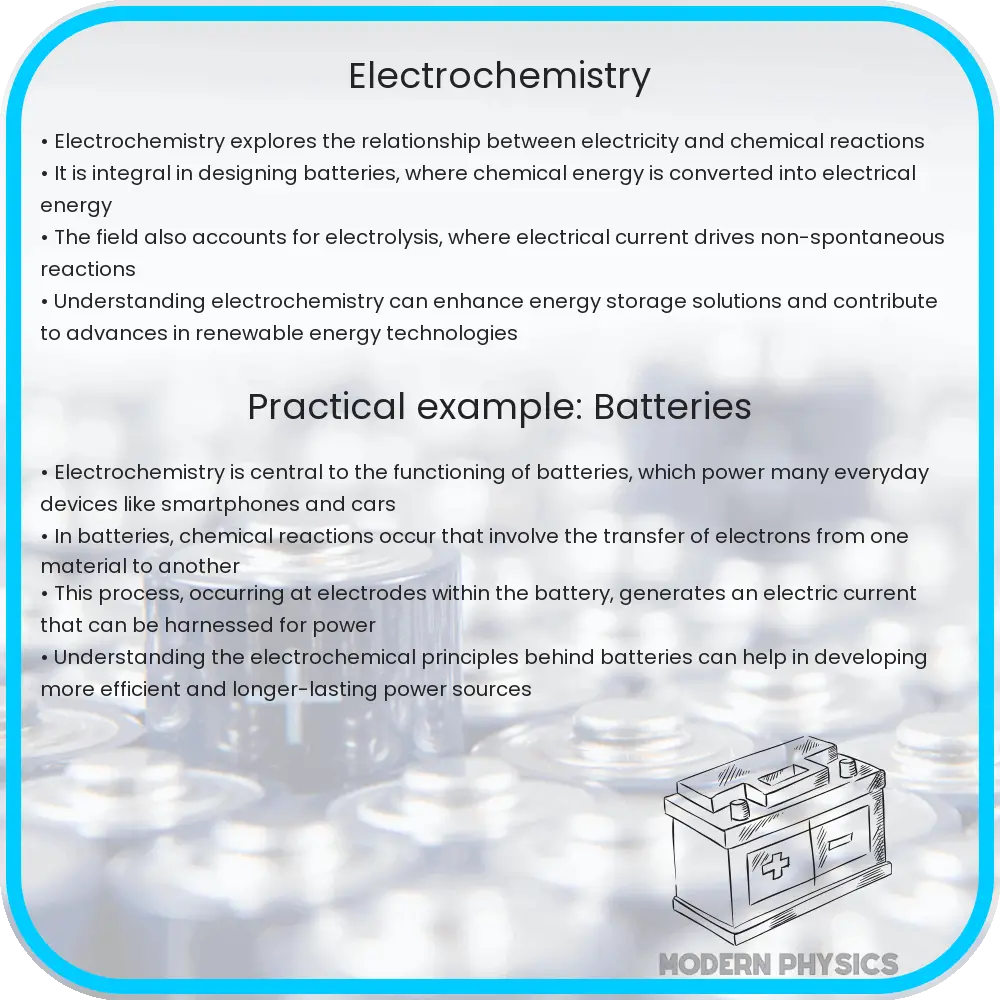Electrochemistry examines the interplay between electrical potential and chemical changes, focusing on electron and ion transfers in reactions.

Introduction to Electrochemistry
Electrochemistry is a branch of chemistry that deals with the relationship between electrical potential and chemical changes. It focuses on the interactions between electrons and ion transfers in chemical reactions that either produce or use electrical energy. Central to the field of electrochemistry are electrochemical cells – devices that convert chemical energy into electrical energy and vice versa.
Basic Principles of Electrochemistry
Two fundamental principles underlying electrochemistry are oxidation-reduction (redox) reactions and the operation of electrochemical cells. In redox reactions, electrons are transferred from one substance to another. Oxidation refers to the loss of electrons, while reduction refers to the gain of electrons.
The standard representation of an electrochemical cell features two electrodes: the anode and the cathode. The anode undergoes oxidation and the cathode undergoes reduction. Electrochemical cells are broadly categorized into two types:
- Galvanic or Voltaic Cells – These cells generate electrical energy from spontaneous chemical reactions. They are commonly used in batteries.
- Electrolytic Cells – These cells drive non-spontaneous chemical reactions through the introduction of electrical energy, commonly seen in processes like electroplating or electrolysis.
The relationship between the potential change, the free energy change, and the equilibrium constant for reactions occurring in electrochemical cells is given by the Nernst equation:
Nernst Equation: E = E0 – (RT/nF) * ln(Q)
Where:
- E is the electrochemical cell potential,
- E0 is the standard electrode potential,
- R is the gas constant (8.314 J/(mol*K)),
- T is the temperature in Kelvin,
- n is the number of moles of electrons transferred,
- F is the Faraday constant (96485 C/mol), and
- Q is the reaction quotient.
Applications of Electrochemistry
Electrochemistry holds a pivotal role in various industrial and technology sectors. Some of its significant applications include:
- Batteries: Electrochemistry is the foundation for primary (non-rechargeable) and secondary (rechargeable) batteries that power many portable electronic devices, electric vehicles, and large-scale energy storage for renewable energy systems.
- Corrosion Prevention: Understanding electrochemical processes helps design better corrosion-resistant materials and protective coatings thereby enhancing the lifespan and safety of structures and machinery.
- Electroplating: This involves depositing a layer of metal onto a conductive surface to improve its appearance, resistance to corrosion, or other properties.
- Water Treatment: Electrochemistry is employed in the electrochemical treatment of wastewater to remove contaminants through processes such as electrocoagulation and electrofloatation.
Each of these applications not only improves product durability and functionality but also contributes to sustainability and environmental preservation.
Innovations in Electrochemistry
Recent innovations in electrochemistry have focused on enhancing energy efficiency and expanding the capabilities of traditional electrochemical devices. Notable advancements include:
- Development of Solid-State Batteries: Researchers are creating solid-state batteries, which offer greater safety and potentially higher energy densities than traditional lithium-ion batteries. These could revolutionize power storage in electric vehicles and portable electronic devices.
- Electrochemical Sensors: These are being increasingly used for environmental monitoring and healthcare, providing sensitive and selective detection of various chemical species.
- Artificial Photosynthesis: Scientists are developing electrochemical systems modeled after photosynthesis to efficiently harness solar energy and convert carbon dioxide into fuels, mimicking the natural process but at a faster rate.
Each of these innovations not only pushes the envelope in their respective fields but also opens new avenues for research and application in electrochemistry.
Environmental Impact of Electrochemistry
Electrochemistry not only advances technology but also plays a crucial role in environmental protection. By enabling cleaner technologies such as electric vehicles and renewable energy systems, electrochemistry reduces reliance on fossil fuels and minimizes greenhouse gas emissions. In water treatment processes, electrochemical methods offer advantages over traditional chemical treatments by avoiding the use of harmful chemicals, thus preventing further environmental pollution.
Conclusion
Electrochemistry is a fascinating and vital field that bridges chemistry and electricity, leading to numerous practical applications that enhance our daily lives and protect our environment. From powering our gadgets and vehicles with batteries to safeguarding our infrastructure against corrosion and treating our wastewater, electrochemistry is integral to modern technological advancements and environmental sustainability. Understanding the basic principles and applications of electrochemistry not only enriches our knowledge but also inspires innovative solutions to future challenges. As the field continues to evolve, its potential to further revolutionize technologies and contribute to a sustainable future remains immense.
